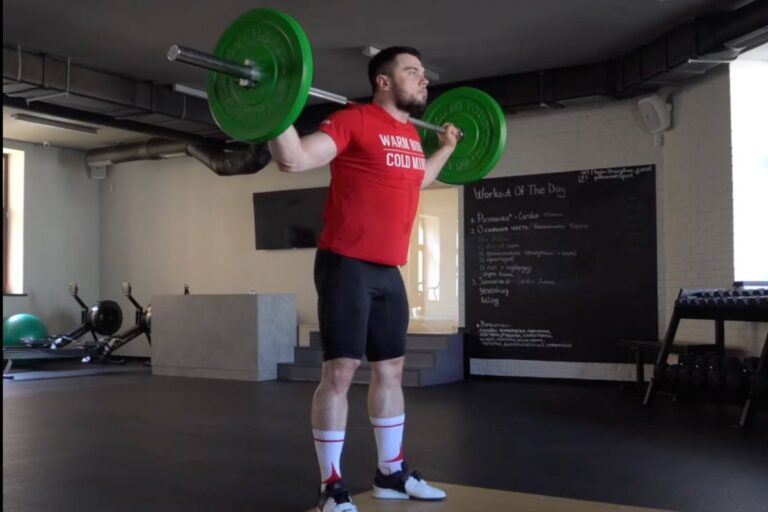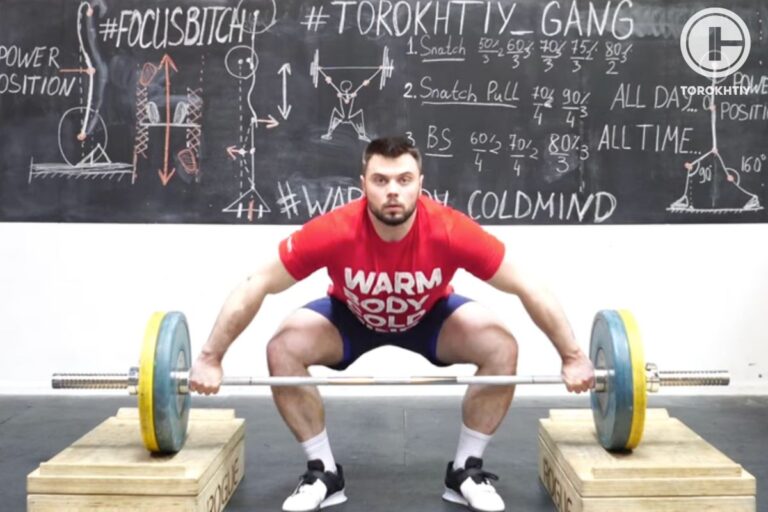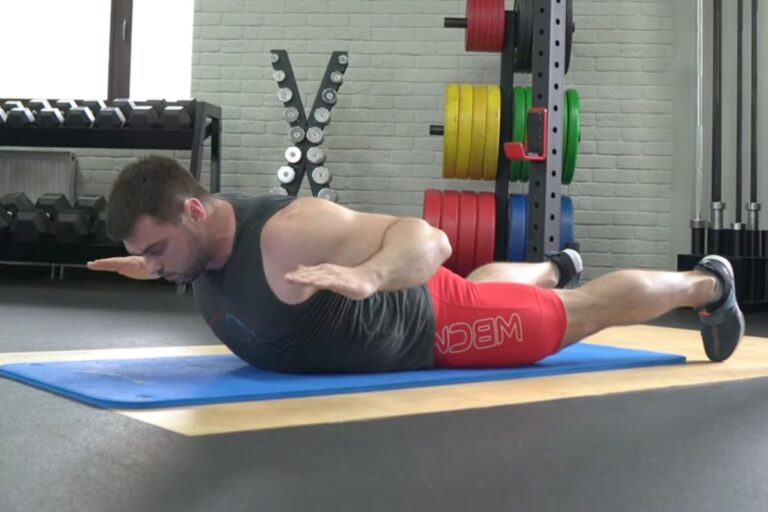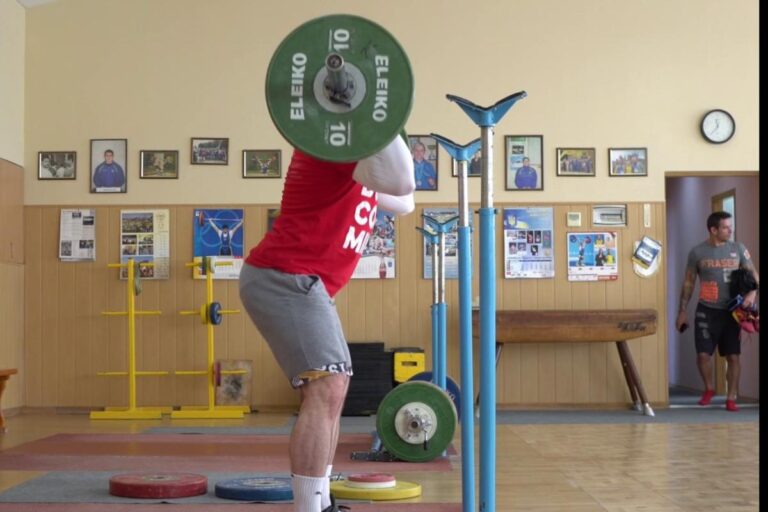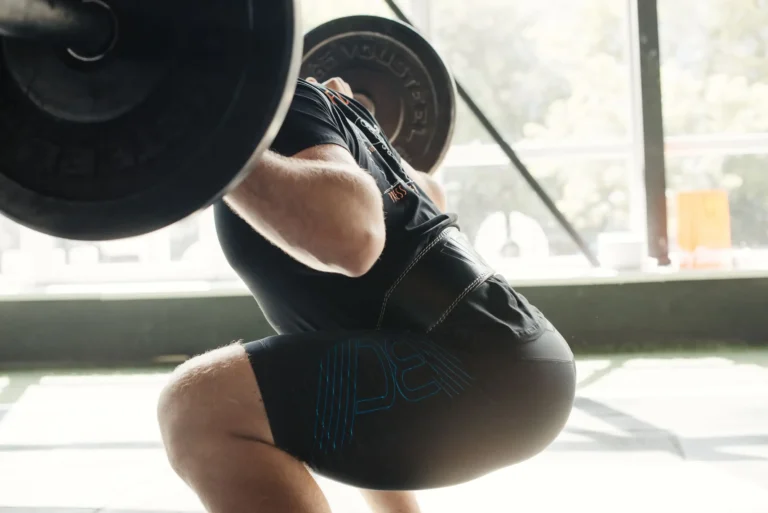Depth Jump
Depth jumps are plyometric exercises used in Olympic weightlifting to improve explosive power, speed, and overall performance. They involve jumping off a box or platform and immediately jumping again upon landing.
Depth jump is the main exercise in the «shock» method of training the leg muscles. This is a jump down, usually from a height of 50-70 cm with an instantaneous jumping up. It is extremely important to land and jump up fast.
What Muscles Are Working In Depth Jumps?
Depth jumps are a plyometric exercise that engages multiple muscle groups in the lower body, including the quadriceps, glutes, hamstrings, calves, and ankles.
During the jump-off phase of the depth jump, the quadriceps, hamstrings, and calves contract to generate force and propel the athlete off the platform. The glutes also play an important role in extending the hips, which helps to generate power and force.
During the landing phase, the lower body muscles work eccentrically to decelerate the body and absorb the impact of the landing. The ankles, in particular, must work to stabilize the body and maintain balance as the athlete lands and prepares for the second jump.
The explosive jump that follows the landing phase requires a coordinated effort from the lower body muscles to generate the necessary force and power to jump as high as possible.
The main purpose in the «shock» method is stimulation of the muscles with shock stretching, preceding the active effort. The mechanics of the depth jump is the following: when an athlete falls from a height – he gains kinetic energy.
Depth Jump Technique
Here’s how to perform a depth jump exercise:
Find a sturdy box or platform that’s at least knee height.
Stand on top of the box or platform with your toes hanging over the edge.
Step off the box or platform and land on both feet.
As soon as your feet make contact with the ground, immediately jump as high as you can.
When landing down, thigh muscles and tibialis anterior muscle perform an eccentric contraction in order to slow the fall, and eccentric contraction is replaced for an instant isometric (i.e. without movement), which is immediately replaced by a concentric contraction, when an athlete jumps up.
Depth Jumps Benefits
Depth jumps are a plyometric exercise that can offer several benefits for Olympic weightlifting, including:
1. Increased Explosive Power
Depth jumps are a highly effective exercise for developing explosive power in the lower body muscles. This is important for weightlifters who need to generate maximum force and power during the clean and jerk and snatch lifts.
2. Improved Jumping Ability
Depth jumps require the athlete to perform a quick and explosive jump after landing. This can help to improve jumping ability, which is important for weightlifters who need to jump and pull the barbell during the C&J and snatch lifts.
3. Increased Speed
Depth jumps can help to improve speed and agility, which can be beneficial for weightlifters during the catch phase of the snatch and C&J.
4. Improved Joint Stability
Depth jumps require the athlete to land softly and with good form, which can help to improve joint stability and reduce the risk of injury during weightlifting.
5. Increased Overall Athletic Performance
Depth jumps can improve overall athletic performance by developing explosiveness, speed, agility, and coordination in the lower body muscles. This can translate to improved performance in other sports and activities.
Overall, depth jumps are a challenging and effective exercise that can offer several benefits for Olympic weightlifters. They should be incorporated into a well-rounded training program that includes strength training, technique work, and other types of plyometric exercises. It’s important to start with a lower box height and progress gradually to avoid injury and ensure proper adaptation.
Optimal Load For Depth Jumps
Depth jumps are typically performed for sets of 5-10 repetitions, with rest intervals of 1-2 minutes between sets. They can be incorporated into a weightlifting program to improve explosiveness during the catch phase of the clean and jerk or snatch lifts, as well as to enhance overall power and speed.
It’s important to note that depth jumps are an advanced plyometric exercise and should only be performed by experienced athletes who have a solid foundation of strength and technique. Depth jump workout can be quite intense on the joints, so proper form and adequate warm-up are crucial to prevent injury.
History Behind Depth Jumps
The shock method was developed by Yuri Verkhoshanskii for the Soviet national team in the early 1970s, renowned Soviet sports scientist and coach. It involves exposing the body to a high-intensity stimulus, followed by a period of rest or low-intensity training, and then repeating the process.
The goal of the shock method is to stimulate the nervous system and muscles to adapt and improve their performance capabilities. By using a high-intensity stimulus, the body is forced to adapt quickly to the stress, which can lead to gains in strength, speed, and power.
The shock method can be applied to various training modalities, including weightlifting, sprinting, jumping, and other explosive movements. Some examples of shock method exercises include:
Depth jumps: Jumping off a box or platform and immediately jumping again upon landing.
Plyometric push-ups: Explosive push-ups that require the athlete to push off the ground with maximum force.
Power cleans: A weightlifting exercise that involves lifting a barbell from the ground to the shoulders in one explosive movement.
To apply the shock method, Verkhoshansky recommended performing high-intensity exercises for short periods of time, followed by longer periods of rest or low-intensity training. He also suggested gradually increasing the intensity of the exercise over time to prevent injury and ensure proper adaptation.
Variations Of Depth Jumps
There are several variations of depth jumps that can be used to add variety and challenge to plyometric training. Here are a few examples:
1. Single Leg Depth Jump
This variation involves jumping off the platform with one leg and landing on the same leg. It is an effective exercise for improving single-leg strength, stability, and explosiveness.
2. Lateral Depth Jumps
In this variation, the athlete jumps off the platform laterally and lands on both feet. This exercise targets the muscles of the inner and outer thighs, as well as the glutes and calves.
3. Box Jump to Depth Jump
This variation combines a box jump with a depth jump. The athlete jumps onto a box or platform, steps off, and immediately performs a depth jump. Box depth jump exercise is particularly effective for developing explosive power in the lower body.
4. Continuous Depth Jumps
This variation involves performing multiple depth jumps in succession, without pausing in between. This exercise is challenging and requires a high level of coordination, balance, and explosive power.
5. Drop Squat Jump
This exercise is similar to a depth jump, but instead of jumping after landing, the athlete drops into a deep squat position and then jumps as high as possible. Drop jumps target the same muscles as a depth jump, but also engages the muscles of the core and upper body.
These are just a few examples of the many depth jump variations that can be incorporated into a plyometric training program. It’s important to choose variations that are appropriate for your fitness level and goals, and to progress gradually to avoid injury.
The shock method is considered an advanced training technique and should only be used by experienced athletes who have a solid foundation of strength and technique. It can be a highly effective way to improve athletic performance, but it requires careful planning and execution to avoid injury and maximize results.
Author: Oleksiy Torokhtiy
Olympic Weightlifting Champion
Best Results: Snatch – 200 kg,
C&J – 240 kg
Oleksiy Torokhtiy is a professional athlete boasting 20 years of experience in Olympic weightlifting. With multiple European and World titles under his belt, he has showcased his prowess in two Olympic Games (Beijing 2008 and London 2012). Upon concluding his illustrious career, Oleksiy dedicated himself to coaching. By 2022, he had conducted over 200 weightlifting seminars worldwide. He is the visionary behind an international sportswear and accessories brand known for its motto, “Warm Body Cold Mind.” Additionally, he is an esteemed author and the creator of a series of training programs and eBooks.


